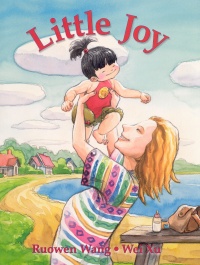| ________________
CM . . .
. Volume XIV Number 12 . . . .February 8, 2008
excerpt:
There is an expanding body of children's picture books that deal with adoption, a topic which is particularly salient as more North American families today are adopting children from Asia. These books often address this topic from the perspective of the foster parent, sibling, or adoptee and explore the issues that surround the process of adoption or of growing up as an adopted child. For example, these include the family's varied and fluctuating emotions that result from the adopted child's arrival, the difficulties that arise from adopted children's perceptions of their physical differences from other family members and people, as well as the struggles and rewarding efforts of adopted children to fit into their new family. Picture books that focus on adopted children from Asia include Deborah Hodge's Emma's Story, Eve Bunting's Jin Woo, Jean Davies Okimoto's The White Swan Express, Ed Young's My Mei Mei, Patricia I. McMahon's Just Add One Chinese Sister, and Stephan Molnar-Fenton's An Mei's Strange and Wondrous Journey, and Jan Czech's An American Face. Ruowen Wang's story Little Joy is ideal for members of a younger audience who are just beginning to develop their English comprehension skills. Structured as a simple story told in simple language, Ruowen Wang's book depicts the developing bond between a white mother and her adopted Chinese girl, Little Joy. This is not to discount the difficulties that adoptees have when they grow up or the desires that they have to locate their birth parents, which books, such as Ting-xing Ye's Throwaway Daughter, sensitively depict. Instead, Wang's story depicts the relationship between a foster mother and her child in a way that young children can comprehend and that new parents of adopted children can also appreciate and enjoy.
Recommended. Huai-Yang Lim has a degree in Library and Information Studies and currently works as a researcher. He enjoys reading, reviewing, and writing children's literature in his spare time.
To comment
on this title or this review, send mail to cm@umanitoba.ca.
Copyright © the Manitoba Library Association. Reproduction for personal
use is permitted only if this copyright notice is maintained. Any
other reproduction is prohibited without permission.
NEXT REVIEW |
TABLE OF CONTENTS FOR THIS ISSUE
- February 8, 2008.
AUTHORS |
TITLES |
MEDIA REVIEWS |
PROFILES |
BACK ISSUES |
SEARCH |
CMARCHIVE |
HOME |
